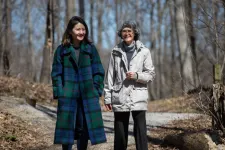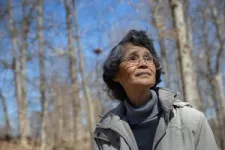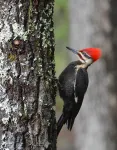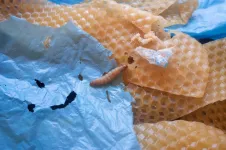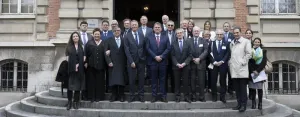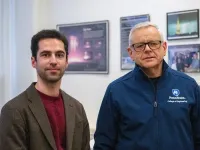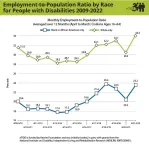(Press-News.org) Researchers are deploying the latest mapping techniques to identify the most important suburban habitat for North America’s largest woodpecker.
University of Cincinnati doctoral student Ruijia Hu said wildlife habitat in congested places like southwest Ohio is becoming increasingly fragmented as forests give way to new construction. Eventually, this could spell trouble to an animal with specific habitat needs like Ohio’s pileated woodpecker.
Pileated woodpeckers are crow-sized birds with colorful red crests and striking white facial stripes. They are found in forests from British Columbia to Florida. They have the nickname carpenter birds for their incessant natural woodworking.
“I think they’re beautiful birds. They were the model for the cartoon character Woody Woodpecker,” Hu said.
They prefer mature woodlands with dead timber that conceals grubs and other preferred food. While they are considered a species of low conservation concern, their particular habitat needs make them potentially vulnerable to human development, Hu said.
Pileated woodpeckers peck out cavities in trees for their nests every year, creating lots of valuable real estate for animals like fox squirrels and screech owls.
“They make new nests every year. They won’t reuse old ones,” Hu said. “Other animals depend on them.”
Pileated woodpeckers are reclusive birds that are more often heard than seen. They make a loud, repetitive chucking call that echoes across the forest canopy. Studying them can be especially tricky. So Hu turned to citizen science for help.
To identify where pileated woodpeckers have been seen in Hamilton County, Ohio, home to Cincinnati and its namesake university, she used eight years of sightings collected by birders and logged into the website eBird, a free online tool and app that anyone can use to record their observations and locations.
She overlaid these sightings with remote sensing data and found that corridors along rivers and creeks with abundant mature trees and deadwood helped the birds adjust to their increasingly fragmented urban landscape. One of the best places for pileated woodpeckers in Hamilton County is found along the Little Miami River.
Then they created a model to identify the most critical habitat corridors, which could help park managers and government planners make better decisions about preserving or restoring the most valuable contiguous forest patches.
Hu presented her findings to the American Association of Geographers’ conference in Denver.
Study co-author and UC Professor Susanna Tong said wildlife corridors are becoming an increasingly important tool to save species in urban spaces.
“With fragmented forests, many habitats that were once suitable for wildlife are broken up,” Tong said. “Wildlife is unable to find habitat big enough to meet their survival needs. And even if there are suitable habitats, the distance between them can be too great.
“Wildlife corridors link up these habitat patches. Since wildlife can travel and migrate from one patch to another, the probability of finding food and shelter is higher and they can still survive in the fragmented landscape.”
While the population of pileated woodpeckers is stable today, that hasn’t always been the case, Hu said.
“This bird’s population saw a huge decline in the late 18th and 19th centuries when a lot of forest was converted to agriculture,” she said. “But when reforestation started, it recovered.”
And the United States has lost similar species in the blink of an eye from sudden habitat loss. Now extinct, the ivory-billed woodpecker was once found from Texas to Florida but disappeared in just a few decades in the early 20th century when timber clear-cutting flattened huge sections of the Southeast.
“There are so many species in urban areas that we don’t pay attention to, especially when they’re not considered vulnerable,” Hu said.
With development chipping away at more forest in this congested county, the tipping point could come quickly and unexpectedly, she said.
“You can’t fix it overnight,” Hu said. “It’s not just about planting more trees. The birds need mature forest, so it could take 30 to 50 years to replace their habitat. At least we can protect these riparian forest corridors and see that existing trees reach maturity.”
END
Can cities make room for woodpeckers?
Researchers say wildlife corridors could help pileated woodpeckers survive forest fragmentation
2023-03-31
ELSE PRESS RELEASES FROM THIS DATE:
Study: ChatGPT has potential to help cirrhosis, liver cancer patients
2023-03-31
A new study by Cedars-Sinai investigators describes how ChatGPT, an artificial intelligence (AI) chatbot, may help improve health outcomes for patients with cirrhosis and liver cancer by providing easy-to-understand information about basic knowledge, lifestyle and treatments for these conditions.
The findings, published in the peer-reviewed journal Clinical and Molecular Hepatology, highlights the AI system’s potential to play a role in clinical practice.
“Patients with cirrhosis and/or liver cancer and their caregivers often have unmet needs and insufficient knowledge about managing and preventing complications of their disease,” ...
A healthy microbiome may prevent deadly infections in critically ill people
2023-03-31
Twenty to 50 per cent of all critically ill patients contract potentially deadly infections during their stay in the intensive care unit or in hospital after being in the ICU – markedly increasing the risk of death.
“Despite the use of antibiotics, hospital-acquired infections are a major clinical problem that persists to be a huge issue for which we don’t have good solutions,” says Dr. Braedon McDonald, MD, PhD, an intensive care physician at the Foothills Medical Centre (FMC) and assistant professor at the ...
Academic institutions receive lower financial returns from biotechnology licenses than commercial firms
2023-03-31
BENTLEY UNIVERSITY
The financial terms of biotechnology licenses from academic institutions are significantly less favorable than those of comparable licenses between commercial firms according to a new study from Bentley University’s Center for Integration of Science and Industry. The study, published in the journal PLOS ONE, shows that the royalties and payments to academic institutions are significantly lower than those to commercial firms for similar licenses and products at the same stages of development.
The article, titled “Comparing the economic terms of biotechnology licenses from academic institutions with those ...
Harnessing nature to promote planetary sustainability
2023-03-31
As Earth’s population grows, the demands of modern lifestyles place mounting strain on the global environment. Proposed solutions to preserve and promote planetary sustainability can sometimes prove more harmful than helpful. However, technologies that harness natural processes could be more successful.
Such technologies are the focus of the latest issue of the open access journal PLOS Biology, which features a special collection publishing March 31st of papers highlighting biology-based solutions that could be applied to reduce carbon dioxide emissions, eliminate non-degradable plastics, produce food or energy ...
Study examines how social rank affects response to stress
2023-03-31
Can an individual’s social status have an impact on their level of stress? Researchers at Tulane University put that question to the test and believe that social rank, particularly in females, does indeed affect the stress response.
In a study published in Current Biology, Tulane psychology professor Jonathan Fadok, PhD, and postdoctoral researcher Lydia Smith-Osborne looked at two forms of psychosocial stress — social isolation and social instability — and how they manifest themselves based on social rank.
They conducted their research on adult female mice, putting them in pairs and allowing them to form a stable ...
The stars in the brain may be information regulators
2023-03-31
Long thought of as “brain glue,” the star-shaped cells called astrocytes—members of a family of cells found in the central nervous system called glial that help regulate blood flow, synaptic activity, keep neurons healthy, and play an important role in breathing. Despite this growing appreciation for astrocytes, much remains unknown about the role these cells play in helping neurons and the brain process information.
“We believe astrocytes can add a new dimension to our understanding of how external and internal information is merged in the ...
The Institut Pasteur and the University of São Paulo sign articles of association to establish the Institut Pasteur in São Paulo
2023-03-31
On Friday March 31st, 2023 at a ceremony in Paris, the Institut Pasteur President, Professor Stewart Cole, and the University of São Paulo (USP) Rector, Carlos Gilberto Carlotti Junior, signed articles of association for the Institut Pasteur in São Paulo, a private non-profit organization under Brazilian law. The mission of the institute, an associate member of the Pasteur Network, is to conduct research in the field of biology that contributes to the development of human health, and to promote outreach, education, innovation and knowledge transfer activities and public health measures.
The Institut Pasteur ...
Mathematical model provides bolt of understanding for lightning-produced X-rays
2023-03-31
UNIVERSITY PARK, Pa. — In the early 2000s, scientists observed lightning discharge producing X-rays comprising high energy photons — the same type used for medical imaging. Researchers could recreate this phenomenon in the lab, but they could not fully explain how and why lightning produced X-rays. Now, two decades later, a Penn State-led team has discovered a new physical mechanism explaining naturally occurring X-rays associated with lightning activity in the Earth’s atmosphere.
They published their ...
nTIDE March 2023 Deeper Dive: Intersection of race and disability perpetuate inequalities in employment impacting Black/African American people with disabilities
2023-03-31
East Hanover, NJ – March 31, 2023 – Since the pandemic, gains in the labor market have been slower to materialize for black/African American people with disabilities compared to their white counterparts, according to experts speaking last Friday during the nTIDE Deeper Dive Lunch & Learn Webinar. They discussed potential factors underlying why the disability employment gap is wider among members of the black/African American population when compared to the white population and how to integrate measures to effect change.
Using data from the U.S. Bureau of Labor Statistics (BLS) for persons ages 16-64, the monthly employment-to-population ratio averaged ...
Researchers uncover the first steps driving antibiotic resistance
2023-03-31
Antibiotic resistance is a global health threat. In 2019 alone, an estimated 1.3 million deaths were attributed to antibiotic resistant bacterial infections worldwide. Looking to contribute a solution to this growing problem, researchers at Baylor College of Medicine have been studying the process that drives antibiotic resistance at the molecular level.
They report in the journal Molecular Cell crucial and surprising first steps that promote resistance to ciprofloxacin, or cipro for short, one of the most commonly prescribed antibiotics. The findings point at potential ...
LAST 30 PRESS RELEASES:
Collaborative study uncovers unknown causes of blindness
Inflammatory immune cells predict survival, relapse in multiple myeloma
New test shows which antibiotics actually work
Most Alzheimer’s cases linked to variants in a single gene
Finding the genome's blind spot
The secret room a giant virus creates inside its host amoeba
World’s vast plant knowledge not being fully exploited to tackle biodiversity and climate challenges, warn researchers
New study explains the link between long-term diabetes and vascular damage
Ocean temperatures reached another record high in 2025
Dynamically reconfigurable topological routing in nonlinear photonic systems
Crystallographic engineering enables fast low‑temperature ion transport of TiNb2O7 for cold‑region lithium‑ion batteries
Ultrafast sulfur redox dynamics enabled by a PPy@N‑TiO2 Z‑scheme heterojunction photoelectrode for photo‑assisted lithium–sulfur batteries
Optimized biochar use could cut China’s cropland nitrous oxide emissions by up to half
Neural progesterone receptors link ovulation and sexual receptivity in medaka
A new Japanese study investigates how tariff policies influence long-run economic growth
Mental trauma succeeds 1 in 7 dog related injuries, claims data suggest
Breastfeeding may lower mums’ later life depression/anxiety risks for up to 10 years after pregnancy
Study finds more than a quarter of adults worldwide could benefit from GLP-1 medications for weight loss
Hobbies don’t just improve personal lives, they can boost workplace creativity too
Study shows federal safety metric inappropriately penalizes hospitals for lifesaving stroke procedures
Improving sleep isn’t enough: researchers highlight daytime function as key to assessing insomnia treatments
Rice Brain Institute awards first seed grants to jump-start collaborative brain health research
Personalizing cancer treatments significantly improve outcome success
UW researchers analyzed which anthologized writers and books get checked out the most from Seattle Public Library
Study finds food waste compost less effective than potting mix alone
UCLA receives $7.3 million for wide-ranging cannabis research
Why this little-known birth control option deserves more attention
Johns Hopkins-led team creates first map of nerve circuitry in bone, identifies key signals for bone repair
UC Irvine astronomers spot largest known stream of super-heated gas in the universe
Research shows how immune system reacts to pig kidney transplants in living patients
[Press-News.org] Can cities make room for woodpeckers?Researchers say wildlife corridors could help pileated woodpeckers survive forest fragmentation
